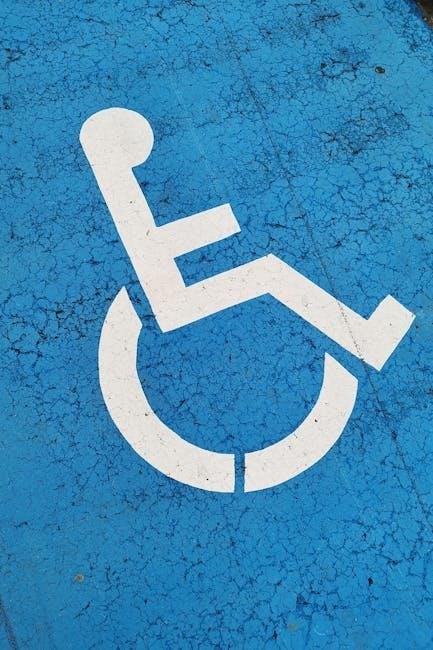Supplementary aids and services are supports provided to students with disabilities to enable participation in education. These include assistive technology, academic support, and behavioral interventions, ensuring inclusive learning opportunities.
What are Supplementary Aids and Services?
Supplementary aids and services are defined under 34 CFR 300.42 as aids, services, and other supports provided to children with disabilities. These are designed to enable participation in regular education classes, extracurricular activities, and other school-related settings. They may include accommodations, modifications, assistive technology, and behavioral supports. These services are tailored to meet individual student needs and ensure access to the curriculum. Examples include extended time for assignments, assistive listening devices, and academic support services. The goal is to provide the necessary tools and environments to help students with disabilities succeed alongside their peers. These aids and services are documented in a student’s IEP and are essential for fostering inclusive education. They cover a wide range of needs, from physical accommodations to social-emotional supports, ensuring equitable learning opportunities.
Importance in Education
The importance of supplementary aids and services lies in their ability to create inclusive learning environments. By providing tailored supports, these services ensure students with disabilities can access the curriculum and participate fully in educational activities. They play a critical role in promoting academic success, social interaction, and emotional well-being. Supplementary aids and services are essential for fostering equity and ensuring that all students, regardless of their abilities, have opportunities to thrive. They also help schools comply with legal requirements, such as IDEA, by addressing individual needs. Ultimately, these supports empower students with disabilities to reach their full potential, preparing them for future success in education and beyond. Their implementation is vital for creating a supportive and inclusive educational system.

Legal Framework
Supplementary aids and services are legally mandated under the Individuals with Disabilities Education Act (IDEA). They ensure students with disabilities receive supports necessary for a free, appropriate public education.
IDEA Regulations and Definitions
Under the Individuals with Disabilities Education Act (IDEA), supplementary aids and services are defined as supports provided to students with disabilities. These include aids, services, and other supports that enable students to participate in regular education classes, extracurricular activities, and other school-related settings. IDEA regulations, specifically 34 CFR 300.42, outline that these supports must be tailored to meet the individual needs of students, ensuring they can access and benefit from their education. The provision of these aids and services is a legal requirement, aiming to promote inclusivity and equal educational opportunities. IDEA emphasizes that supplementary aids and services should be documented in the student’s Individualized Education Program (IEP) and reviewed regularly to ensure effectiveness and compliance with federal standards.
Key Provisions Under 34 CFR 300.42
34 CFR 300.42 outlines the legal provisions for supplementary aids and services, emphasizing their role in supporting students with disabilities. These provisions require that aids, services, and supports be provided in various settings, including general education classrooms, special education environments, nonacademic, and extracurricular activities. The regulations mandate that these supports are tailored to enable students with disabilities to participate meaningfully in educational programs. They also stress that supplementary aids and services must be documented in the student’s Individualized Education Program (IEP) and reviewed periodically to ensure they remain effective and necessary. This legal framework ensures that students receive the accommodations and supports required to access a free and appropriate public education (FAPE), aligning with the broader goals of inclusivity and equity in education.

Examples of Supplementary Aids and Services
Examples include assistive technology devices, such as speech-to-text software, and academic support services, like note-takers or extended time for assignments, ensuring accessibility and inclusivity in education.
Assistive Technology Devices
Assistive technology devices are tools specifically designed to help students with disabilities access educational content and participate fully in learning activities. These devices can range from simple solutions, such as magnifying glasses or ergonomic furniture, to more complex technologies, like screen readers, speech-to-text software, or communication devices. They are often tailored to meet the unique needs of individual students, ensuring they can engage effectively with curriculum materials and classroom environments. For example, a student with visual impairments might use a braille display or text-to-speech software, while a student with mobility challenges could benefit from adaptive keyboards or mice. These technologies not only enhance accessibility but also empower students to achieve their academic goals independently, fostering inclusivity and equity in education.
Academic Support Services
Academic support services are interventions designed to help students with disabilities access and succeed in educational environments. These services may include tutoring, note-taking assistance, study skills training, and test accommodations. For instance, a student with dyslexia might receive additional reading support, while a student with organizational challenges could benefit from homework assistance. These services are often provided in small group or one-on-one settings, tailored to address specific academic needs. They aim to bridge gaps in learning, ensuring students can meet grade-level expectations. Academic support services are essential for fostering independence and confidence, enabling students to fully engage with their curriculum and achieve their academic potential. By addressing individual learning barriers, these services play a critical role in promoting educational equity and inclusion. They are a key component of supplementary aids and services, ensuring students receive the support they need to thrive.

Supplementary Aids and Services in IEPs
Supplementary aids and services are detailed in a student’s IEP to ensure personalized support. These services are tailored to meet individual needs, fostering academic and social growth effectively.
Identification and Documentation Process
The identification of supplementary aids and services begins with an IEP team assessment of a student’s unique needs. This involves reviewing academic performance, functional abilities, and social interactions to determine necessary supports. The process ensures that aids and services are tailored to facilitate access to the general education curriculum and promote participation in school activities. Documentation is critical, with detailed descriptions of each aid or service, including frequency, duration, and settings where they will be provided. This ensures accountability and consistency across all educational environments. The IEP must legally outline these supports, making them binding for implementation. Examples include assistive technology, extended time, or behavioral interventions, all aimed at fostering an inclusive and supportive learning environment for students with disabilities.
Review and Revision Procedures
The review and revision procedures for supplementary aids and services ensure that supports remain relevant and effective. The IEP team reviews these aids annually or as needed, using data to assess their impact on student progress. Revisions are made to reflect changes in a student’s needs, with documentation updated accordingly. This process ensures that services evolve alongside the student’s development. Parents, educators, and the student, when appropriate, collaborate to determine necessary adjustments. The framework guarantees accountability, ensuring that supports align with educational goals and legal requirements. Regular reviews help maintain the effectiveness of supplementary aids and services, fostering continued student success and participation in educational settings.

Purpose and Benefits
The purpose and benefits of supplementary aids and services are to support inclusive education, enhance student participation, and ensure equal access to learning opportunities for all students.
Supporting Inclusive Education
Supplementary aids and services play a critical role in fostering an inclusive educational environment. By providing tailored supports such as assistive technology, behavioral interventions, and academic accommodations, these aids ensure that students with disabilities can fully engage in learning alongside their peers. Inclusive education is strengthened when these supports are integrated into general education classrooms, enabling all students to access the curriculum and participate in activities. The use of supplementary aids and services promotes equity, allowing students with diverse needs to thrive academically and socially. These supports are essential for creating a learning environment where every student feels valued and empowered to succeed. By addressing individual needs, supplementary aids and services help bridge gaps and ensure that no student is left behind in their educational journey.
Enhancing Student Participation
Supplementary aids and services are instrumental in enhancing the active participation of students with disabilities in educational activities. These supports, such as assistive technology, extended time for assignments, and behavioral interventions, ensure that students can fully engage in both academic and extracurricular settings. By addressing individual needs, these aids promote meaningful involvement, enabling students to interact with peers and access the curriculum effectively. For example, a student with a reading disability may benefit from text-to-speech software, while another with mobility challenges might use adaptive equipment to participate in physical activities. Such supports not only foster academic success but also encourage social interaction and a sense of belonging, creating a more inclusive and dynamic learning environment that values diversity and promotes equitable opportunities for all students.

Tools for Identification
Checklists and assessments are key tools for identifying supplementary aids and services, helping teams determine the most appropriate supports for students with disabilities.

Checklists and Assessments
Checklists and assessments are essential tools for identifying supplementary aids and services, providing a structured approach to determine student needs. These resources help educators systematically evaluate which supports are necessary to ensure student participation and progress. By using these tools, IEP teams can align services with individual requirements, ensuring interventions are tailored and effective. Checklists often include examples of potential aids, such as assistive technology or environmental modifications, guiding teams to consider a wide range of possibilities. Assessments, on the other hand, provide data-driven insights, helping to pinpoint specific supports needed. Together, they facilitate a comprehensive and personalized approach to supporting students with disabilities, ensuring that supplementary aids and services are both appropriate and impactful.
The Supplementary Aids and Services Toolkit
The Supplementary Aids and Services Toolkit is a comprehensive resource designed to guide IEP teams in identifying and implementing supports for students with disabilities. It provides a structured, student-focused approach to determine which aids and services are necessary to ensure participation in general education settings. The toolkit includes five key components: forms, guides, examples, assessment tools, and implementation strategies. These components help teams systematically evaluate a student’s needs and develop tailored solutions. By emphasizing collaboration and data-driven decision-making, the toolkit ensures that supplementary aids and services are both effective and aligned with individual student goals. It serves as a valuable tool for educators and families, promoting consistency and equity in supporting students with diverse needs.